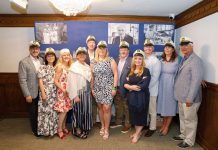
Beethoven’s 9th Symphony, in particular the choral finale “Ode to Joy,” is one of the most renowned and recognized pieces of classical music in the world.
It conjures up many different things to many different people. However, seeing hundreds of children, grades K-6 humming the tune and using hand movements to demonstrate their understanding of the “A-A-B-A” form that is heard throughout the piece, is a whole new experience.
But that was the experience at Harbor View Elementary School, and it was part of the Frieda Belinfante Class Act partnership, Pacific Symphony’s flagship youth education program. Before the finale, the students had listened to a storyteller recount Ludwig Von Beethoven’s life,while a Pacific Symphony violinist Nancy Eldridge played along.
Only 30 schools out of a total of 700 in the county participate in the Frieda Belinfante Class Act program. Three of them are in Newport Beach: Harbor View, Andersen and Newport Coast Elementary. The schools are accepted into the program through a competitive application process.
Pacific Symphony musicians are specially trained and placed in yearlong residencies with these K-6 schools. Through a series of lessons, workshops and concerts, these resident musicians will introduce the students, teachers and parents to the life and music of the “composer of the year” and to their own lives as musicians with an orchestra. Over the years, Class Act has introduced to students American, Russian and German composers such as Gershwin, Williams, Bernstein, Tchaikovsky, Prokofiev, Stravinsky, Dvorak, Mozart, Bach, and this year’s composer, Beethoven.
The Class Act program generally kicks off with a “Prelude Assembly” attended by the entire student body. A professional storyteller, who uses props and student participation to get the kids interested in the life of the featured musician, hosts the assembly. The students and teachers are introduced to their Class Act musician/teaching artist, and they learn about the instrument he/she plays.
Then, throughout the year, classroom lessons are presented to each grade level and taught by the resident musician. The lessons are grade appropriate and follow the standards based music curriculum.
The school also incorporates a “Family Night” performance for students and their families led by their school’s musician and performed by a symphony quintet.
The year concludes with a “Bravo Assembly” featuring each classroom’s own creative expression of what was learned throughout the year. Each class can choose to express itself through dance, music, theater, writing or visual art presentations.
Finally, students in grades 2 and higher are bused to the Segerstrom Concert Hall for a performance by the entire symphony, where they have a chance to see their musicians in a performance that features the works of the composer they have studied.
The K-1 students have a special on-site “interactive music experience” as their culminating experience.
Susan Miller, the symphony’s director of education and community programs, says one of the most unique things about Class Act is that it allows students, teachers, principals, and parents to interact with world-class symphony musicians in a personal and meaningful way.
“Not only are the musicians providing a standards-based, developmentally appropriate music curriculum, but they are also open a whole world of possibilities for students to imagine,” Miller said. “Students see the value of hard work, dedication, and reaching for your dreams, and the possibility of a life in music through their interactions with our musicians and staff. Many students are inspired to study an instrument or continue their studies in music because of Class Act.”
Lynne Abraham-Yadlin, the regional manager and curriculum coordinator for Class Act, started out a volunteer and the opportunity has blossomed into a fulfilling career of bringing the program to Orange County schools.
“The value of the program,” she says, “is that it brings this kind of music to kids who otherwise might not get exposed to it. It seems like everywhere I go there are those few kids who have something in the core of their beings that is stirred by the music. You see it on their faces when they perform at the Bravo. They may not become musicians, but Class Act opens a door to a love of and involvement with music that they might otherwise not have gotten.”
She also stresses how crucial the parent and school component is.
“One thing that is very clear is that the program would not be able to succeed at all without the support and dedication of the schools and parents,” she said. “I think what makes it unique is that it’s truly a partnership with the school. We ask very little in the way of financial payment from the schools, but we do ask for an investment of time, energy and support.”
Charlene Metoyer, principal of Harbor View Elementary, is thrilled to have the program at the school.
“The exposure to real musicians who are dedicated and passionate about their music can’t be duplicated in any in-school program,” she says. “Children gain insights into music theory, instruments, composers and all by connecting with first-class symphony musicians.”
For more information about Pacific Symphony’s Frieda Belinfante Class Act partnership, visit www.pacificsymphony.org




